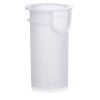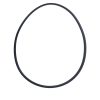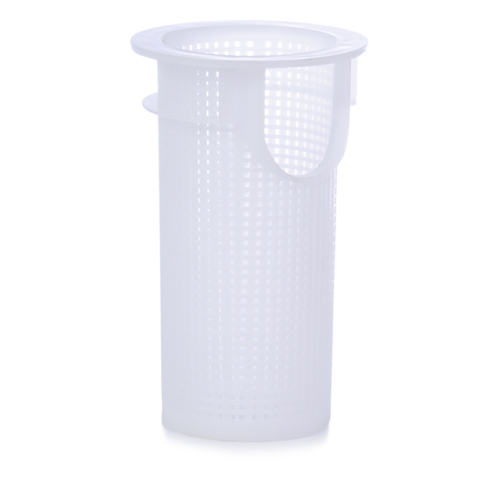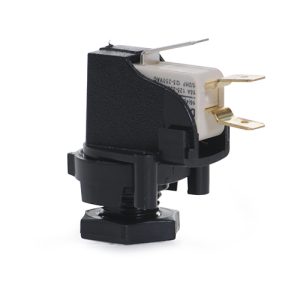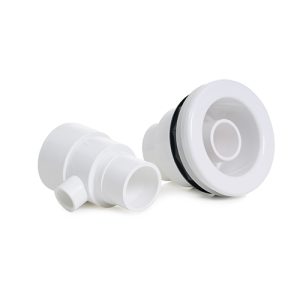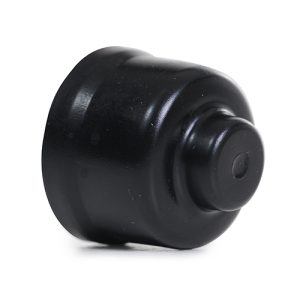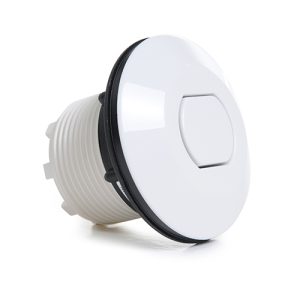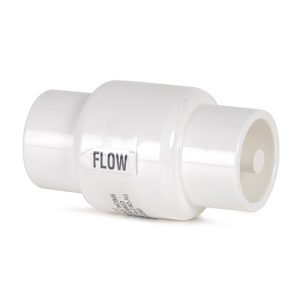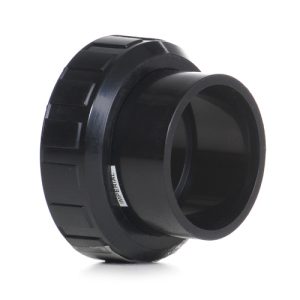Aquamite Pump Basket
Essential Debris Protection for Your Pump
As a retailer of pool and spa parts, I stock this replacement strainer basket for Aquamite pumps. This simple but critical component protects your pump’s impeller from debris, preventing damage and ensuring reliable operation throughout the swimming season.
What is a Pump Basket?
The pump basket (also called a strainer basket or hair and lint trap) is a cylindrical mesh container that sits inside the pump housing ahead of the impeller. As water flows from the pool through the skimmers and main drain, it passes through this basket before reaching the pump’s internal components.
The basket’s mesh construction allows water to flow freely while capturing leaves, twigs, insects, hair, grass clippings, and other debris that would otherwise enter the impeller area. This filtration is your pump’s first line of defence against damage from foreign objects.
Made from durable plastic with reinforced construction, the basket must withstand constant water flow, chemical exposure, and the physical stress of being repeatedly removed and reinstalled during cleaning.
Why the Pump Basket is Critical
Without a functioning basket, debris flows directly into the impeller where it can cause immediate and severe damage. Small stones chip impeller vanes, sticks jam between components, and accumulated debris clogs the impeller eye, dramatically reducing flow and potentially causing pump failure.
The basket also provides visual monitoring of your pool’s cleanliness. By checking the basket regularly, you can gauge how much debris is entering the system and spot unusual items that might indicate problems—like chunks of pool plaster, equipment parts, or excessive amounts of leaves suggesting your skimmer baskets need emptying.
A clear or translucent basket design lets you see debris accumulation without removing the pump lid, though regular inspection by actually removing the basket provides better visibility and allows thorough cleaning.
Signs Your Basket Needs Replacement
Visible cracks, splits, or broken sections in the basket body or mesh indicate replacement is needed. Even small cracks can allow debris to pass through, defeating the basket’s protective purpose. Damage often occurs around the handle area where stress concentrates during removal.
If the basket no longer fits snugly in its housing, it may have warped from heat exposure or chemical damage. A loose basket can shift during operation, potentially blocking water flow or allowing debris to bypass the basket entirely.
Severely clogged baskets that won’t come clean even after thorough washing have reached the end of their useful life. Algae, oils, and mineral deposits can penetrate the mesh structure, reducing water flow and making cleaning impossible.
Brittle plastic that cracks easily when squeezed indicates UV or chemical degradation. Baskets exposed to direct sunlight or aggressive water chemistry become fragile over time, breaking unexpectedly during routine cleaning.
Missing or damaged handles make basket removal difficult and frustrating. While technically the basket still functions, the inconvenience often leads to less frequent cleaning, which compromises pump protection.
Common Causes of Basket Damage
Physical stress from forceful removal or installation cracks baskets, especially when they’re wedged tightly in the housing or full of compacted debris. Always remove baskets gently, rocking them slightly if needed rather than yanking forcefully.
UV exposure from direct sunlight degrades plastic over time. Pumps installed without shade or covers age faster, with baskets becoming brittle and prone to cracking. The constant exposure makes the plastic chalky and weak.
Chemical attack from pool sanitizers gradually weakens basket material. While designed for chemical resistance, prolonged exposure to high chlorine levels, particularly during shocking, accelerates degradation. Acidic or highly alkaline water conditions compound this effect.
Freeze damage occurs when water trapped in the basket freezes during winter. The expanding ice cracks the plastic. Proper winterization includes removing and draining the basket to prevent this damage.
Age and repeated cleaning cycles eventually take their toll. The constant flexing during installation and removal, combined with environmental exposure, causes material fatigue that leads to cracking or splitting.
Proper Basket Maintenance
Empty the pump basket at least twice weekly during swimming season, more frequently if you have heavy debris loads from nearby trees or landscaping. Regular cleaning maintains optimal water flow and prevents debris from compacting so tightly it becomes difficult to remove.
When cleaning the basket, use a garden hose to flush debris thoroughly. For stubborn material, soak the basket in a bucket of water mixed with a small amount of dish soap, then rinse thoroughly before reinstalling.
Inspect the basket during each cleaning for developing cracks or damage. Early detection allows replacement before complete failure leaves your impeller unprotected.
Never run the pump without the basket in place, even briefly. The few seconds it takes to reinstall the basket after cleaning can prevent expensive impeller or seal damage from debris ingestion.
Store the basket properly during winter. Clean it thoroughly, allow it to dry completely, and keep it away from direct sunlight and extreme temperatures. Proper storage extends basket life between seasons.
Installation Tips
Ensure the basket seats properly in its recess in the pump housing. It should sit flat and stable, not tilted or raised. Improper seating can restrict water flow or allow debris to bypass the basket.
When reinstalling the pump lid, make sure no debris sits on the O-ring or sealing surface. Even small particles prevent proper sealing, causing air leaks that make the pump lose prime.
Don’t force the basket into position. If it doesn’t fit easily, check for debris in the housing or damage to the basket that’s preventing proper installation. Forcing can crack the basket or damage the housing.
After reinstalling the basket and lid, verify the pump primes properly. If it struggles to prime or pulls air, recheck the basket installation and lid seal—the basket may be positioned incorrectly, preventing proper water flow.
Basket Cleaning Frequency
Cleaning frequency depends on your pool’s environment. Pools surrounded by trees may require daily basket cleaning during autumn leaf drop. Pools in open areas might need cleaning only 2-3 times weekly.
Monitor return jet strength as an indicator of basket condition. Noticeably weaker jets often mean the basket has filled with debris and needs cleaning. Don’t wait for dramatic flow reduction—clean before performance suffers significantly.
Check the basket more frequently after storms, heavy pool use, or when you notice excessive debris on the water surface. These conditions increase debris load and fill the basket faster than normal.
During spring opening, inspect and clean the basket thoroughly even if it appears clean from winterization. Debris, algae, or mineral deposits may have accumulated during the off-season.
Compatibility
This replacement basket is specifically sized for Aquamite pump models. The diameter, height, and mesh design match these pumps’ housing dimensions and flow characteristics. Using the correct basket ensures proper fit, optimal flow, and effective debris capture.
The Aquamite pump line is popular for residential pools and spas, making this basket a frequently needed replacement component. Its compact design suits smaller equipment installations while providing adequate debris capacity for typical residential use.
Product Specifications
| Specification | Details |
|---|---|
| Product Type | Pump Strainer Basket |
| Compatibility | Aquamite pumps (all horsepower ratings) |
| Function | Captures debris before it reaches impeller |
| Material | Chemical-resistant plastic with mesh structure |
| Application | Installs in pump housing ahead of impeller |
| Handle | Integrated handle for easy removal |
| Weight | 0.15 kg |
| Dimensions (L × W × H) | 0.13 m × 0.13 m × 0.21 m |
| Volume | 0.004 cubic meters |
| SKU | 6497240066 |
| Category | Pool & Spa Spares |
Best Practices
Keep a spare basket on hand so you always have a replacement available. When the primary basket needs cleaning during pump operation, you can quickly swap it with the spare, maintaining continuous circulation while you clean the dirty basket at your convenience.
Never let debris compact so tightly in the basket that it becomes difficult to remove. This compaction can permanently deform the basket and makes cleaning frustratingly difficult. Empty the basket before it fills completely.
Rinse the basket immediately after removal rather than letting debris dry. Dried organic matter bonds to the plastic and becomes much harder to remove than fresh debris.
Protect outdoor pumps from direct sunlight when possible. Simple pump covers or shade structures extend the life of plastic components including the strainer basket.
During off-season storage, store the basket in a cool, dry location away from chemicals and direct sunlight. Proper storage conditions preserve the plastic and extend useful life.
This essential component protects your pump investment by preventing debris damage to expensive internal components, making regular basket maintenance one of the most important and cost-effective pool care tasks you can perform.
| Weight | 0.15 Kilograms |
|---|---|
| Length | 0.13 Meters |
| Width | 0.13 Meters |
| Height | 0.21 Meters |
| Volume | 0.004 CubicMeters |
| Supplier | GoldenC |
Related products
Spares
Spares

